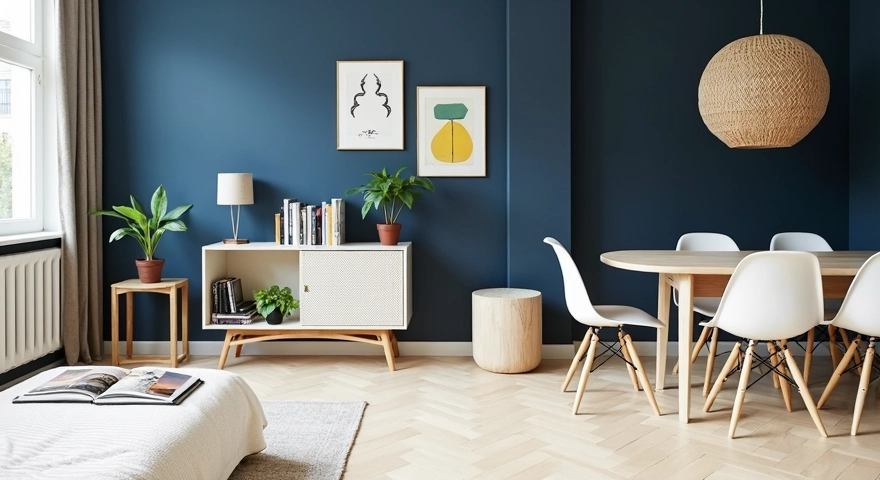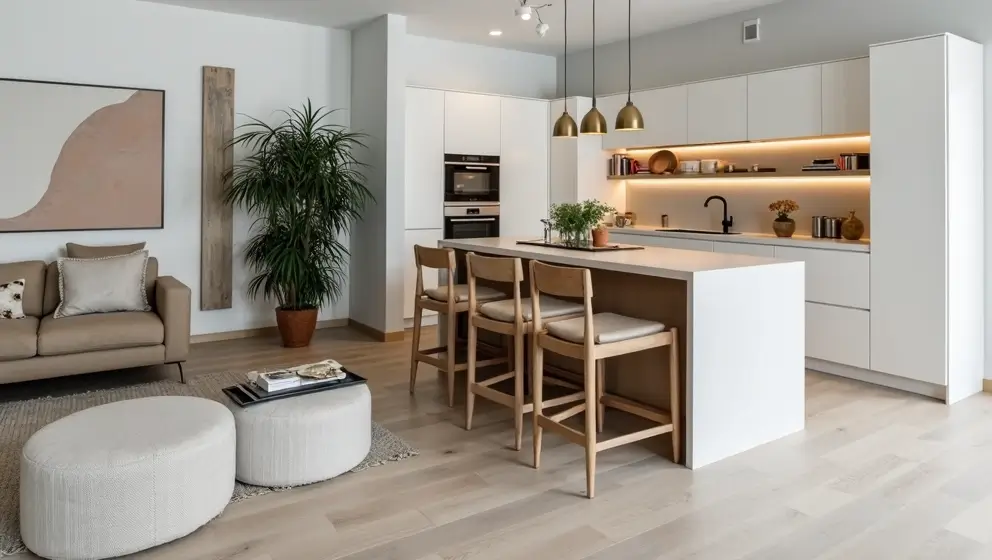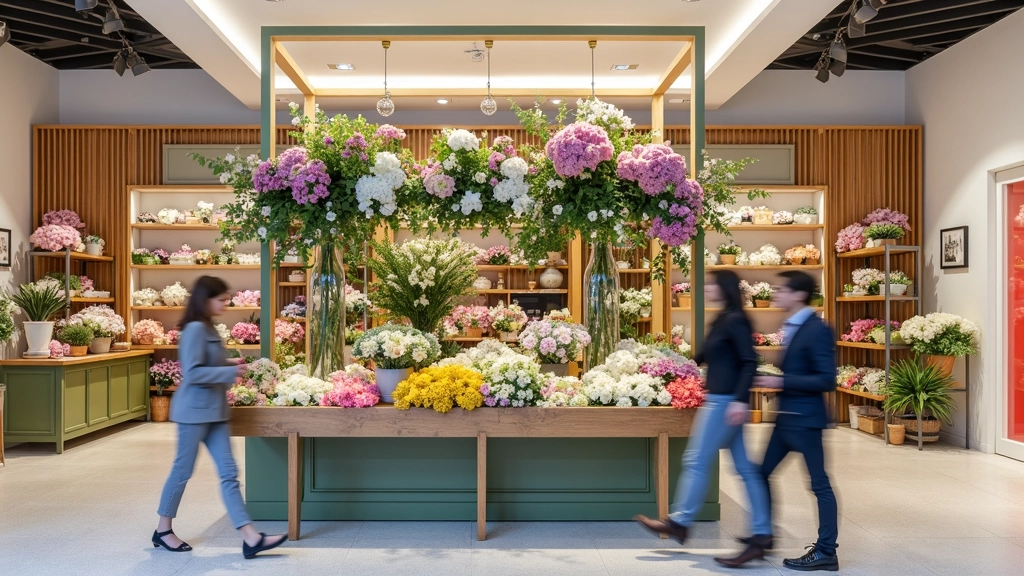Multifunctional Spaces: What Are They and How to Optimize Space?
Multifunctional spaces aim to maximize the use of available space by using the same area for different functions.
What Are Multifunctional Spaces?
Multifunctional spaces are those designed and structured to fulfill multiple functions and activities within the same area. Unlike traditional spaces, which usually have a specific function (such as a living room, bedroom, or office), multifunctional spaces allow the same place to be used in different ways according to current needs.
The concept of multifunctional spaces is based on the idea of maximizing the utility of limited space. The goal is for these spaces to be versatile, flexible, and adaptable. Some key characteristics include:
-
Flexibility of Use: A multifunctional space can be easily reconfigured to meet different functions. For example, a dining room can be transformed into a home office by simply changing the furniture arrangement.
-
Intelligent Design: These spaces often incorporate design solutions that facilitate their multiple uses, such as modular furniture, hidden storage systems, and mobile walls that allow quick reorganization of the environment.
-
Space Utilization: In a multifunctional space, every square meter is optimized to offer maximum performance, allowing reduced areas to accommodate multiple activities.
Multifunctional spaces can be found in a variety of contexts, from homes to offices and public spaces:
-
At Home: A typical example is a living room that converts into a dining room and a home office. Through the use of foldable or modular furniture, the space can quickly adapt to accommodate different needs, such as receiving visitors, working, or enjoying a meal.
-
In Offices: In work environments, multifunctional spaces are essential for creating areas that can be used for meetings, individual work, or team collaboration, all within the same place. Coworking offices, with shared and private areas that can be reconfigured as needed, are a clear example.
-
In Public Spaces: Parks and urban squares can be designed to serve multiple purposes, such as play areas, rest zones, and event spaces. The inclusion of mobile furniture and modular green areas allows these spaces to adapt to different events and community needs.
Changes in Multifunctional Spaces
Multifunctional spaces have gained increasing importance due to various social, economic, and technological trends that have transformed the way we live and work. The relevance of these spaces is manifested in several aspects:
Changes in Lifestyle
Contemporary lifestyle is marked by a growing demand for flexibility. People today seek spaces that can adapt to different activities, from working to relaxing, without the need for major transformations. This trend is partly due to the increase in remote work and teleworking, which has generated the need to integrate offices into the home without sacrificing the comfort or functionality of residential areas.
Urbanization and Reduced Spaces
With increasing urbanization, especially in large cities, living space has become more limited and expensive. Multifunctional spaces allow maximizing the use of available square meters, converting a single area into a place capable of satisfying multiple needs. In Japan, the use of multifunctional public spaces is quite common, such as Roppongi Hills (Tokyo) which consists of an urban complex that combines offices, residences, shops, restaurants, an art museum, a cinema, and a hotel, all integrated into the same space. At its center is the Mori Garden, a traditional Japanese garden that offers a quiet space in the midst of the city's hustle and bustle.
Economy and Sustainability
Multifunctional spaces are also a response to the need for more sustainable and economical solutions. Reducing the amount of space needed to fulfill various functions can mean lower costs in terms of rent, furniture, and energy consumption. Additionally, integrating multiple functions into a single space can contribute to a reduced ecological footprint, promoting efficient use of resources.
Well-being and Quality of Life
Finally, multifunctional spaces can contribute to well-being and quality of life by providing an environment that better responds to everyday needs. The ability to adapt the space according to specific use not only improves functionality but can also have a positive impact on mental and emotional health, creating an environment that promotes comfort, productivity, and relaxation.
What Are the Characteristics of Multifunctional Spaces?
As we mentioned before, flexibility and adaptability, design and aesthetics, and efficient use of space are the main characteristics. Let's delve into describing what an ideal multifunctional space should be like.
Flexibility and Adaptability
Flexibility and adaptability are the most important characteristics of multifunctional spaces. These concepts refer to the ability of a space to transform and fulfill different functions according to the needs of the moment.
-
Versatility in Use: A multifunctional space must be able to adapt to various activities without the need for major structural changes. For example, a room that functions as a living room during the day and turns into a bedroom at night thanks to a folding bed.
-
Multifunctional Furniture: The key to achieving flexibility lies in choosing furniture that can fulfill multiple roles, such as sofa beds, expandable tables, or folding desks. These elements allow the space to change quickly to satisfy different purposes.
-
Modular Solutions: Modular systems, which include shelves, sofas, or tables that can be configured in different ways, offer great flexibility. These systems allow reorganizing the space as needed, adjusting to the changing demands of day-to-day life.
-
Integrated Technology: The incorporation of technology, such as automated movable walls or adjustable lighting systems, allows the space to dynamically respond to user needs. For example, a sliding wall can divide a large room into two smaller ones for different activities.
Design and Aesthetics
Design and aesthetics play a crucial role in multifunctional spaces, as they must not only be functional but also visually attractive and coherent with the style of the environment.
-
Integrated Aesthetics: In a multifunctional space, the design must integrate all functions harmoniously. This means that functional elements, such as folding furniture or storage solutions, must be designed to complement the overall style of the space, rather than appearing as incongruent additions.
-
Minimalist Design: Often, multifunctional spaces adopt a minimalist approach in their design, using neutral colors, clean lines, and simple furniture to create an environment that doesn't feel cluttered, despite fulfilling multiple functions.

-
Use of Materials and Textures: The choice of materials and textures is also fundamental. Durable and easy-to-clean materials, such as wood, metal, or resistant fabrics, are ideal for spaces that must withstand frequent and varied use. Additionally, the use of different textures can help define zones within the space, adding visual interest and functionality.
-
Strategic Lighting: Lighting is a key element in the aesthetic and functional design of a multifunctional space. The combination of natural and artificial light, along with the ability to adjust the intensity and color of the light, allows creating suitable environments for different activities, from work to relaxation.
You can create designs of multifunctional spaces through our home staging tool, modifying images with AI to see how your renovation would look before starting construction.
Efficient Use of Space
Efficient use of space is fundamental in multifunctional spaces, especially in urban environments where space is limited and expensive.
-
Maximizing Vertical Space: Taking advantage of vertical space is essential in multifunctional areas. Tall shelves, cabinets that reach the ceiling, and using walls for storage allow freeing up floor space, making the room appear larger and more organized.
-
Intelligent Storage Solutions: Hidden or integrated storage is vital to maintain cleanliness and order in a multifunctional space. Furniture with secret compartments, beds with drawers underneath, and tables with internal storage are examples of how space use can be maximized without compromising functionality.
-
Optimization of Reduced Space: In small areas, every inch counts. Space optimization involves careful planning of furniture and element arrangement to ensure that the space is not only functional but also comfortable and aesthetically pleasing.
How to Make the Most of Multifunctional Spaces?
Making the most of multifunctional spaces requires a combination of strategic planning, creativity in design, and the choice of elements that optimize both functionality and aesthetics. Here are some key strategies to get the most out of multifunctional spaces in your home, office, or any other environment:
Space Planning
Planning is the first crucial step in creating an effective multifunctional space. Consider the following recommendations:
-
Identify Needs: Before designing a multifunctional space, it's important to clearly identify the activities that will take place in that space. Ask yourself: What functions should this space fulfill? Do you need an area to work, relax, eat, or all of the above?
-
Intelligent Zoning: Divide the space into specific zones for each function, using furniture, rugs, or decorative elements to create visual separation between areas. This helps maintain order and allows each activity to have its own place, even in a small environment.
-
Circulation and Accessibility: Make sure that the space distribution allows for unobstructed movement flow. Multifunctional spaces should be comfortable, with a design that facilitates changing from one activity to another without complications.
Selection of Multifunctional Furniture
Furniture is a key piece in any multifunctional space. The choice of appropriate furniture can completely transform the use of an area:
-
Modular Furniture: Opt for modular furniture that can be reorganized according to the needs of the moment. For example, modular sofas that can be configured to create a larger living room or divided into smaller sections.
-
Foldable or Retractable Furniture: Folding tables, chairs, and beds are excellent for multifunctional spaces. This furniture can be stored when not in use, freeing up space for other activities.
-
Intelligent Storage: Furniture with integrated storage, such as beds with drawers underneath or benches with hidden compartments, helps maintain order and reduces the need for additional furniture.
Maximizing Light and Color
Light and color play a crucial role in how we perceive and use multifunctional spaces:
-
Adaptive Lighting: Use lighting that can be adjusted according to the activity, such as dimmable lights or lamps with different intensity levels. This allows creating suitable environments for working, relaxing, or socializing.
-
Color Scheme: Light and neutral colors can make a small space appear larger and more versatile. Consider using a color palette that complements the multifunctionality of the space, with soft tones that don't saturate the environment.
-
Mirrors and Natural Light: Mirrors and natural light are powerful allies for visually expanding a space and making it more welcoming. Strategically placing mirrors can reflect light and give the sensation of greater amplitude.
You can modify the lighting and improve your real estate photography with Pedra to have a new vision of your home.
Personalization and Decorative Details
Although functionality is key, don't forget the importance of personalization and style:
-
Personal Details: Adding decorative elements that reflect your personality, such as art, plants, or photographs, can make a multifunctional space feel more welcoming and unique.
-
Textiles and Accessories: The use of cushions, curtains, and rugs can quickly change the appearance and function of a space. These elements can also serve to define different zones within a multifunctional space.
-
Flexibility in Decoration: Consider using decoration that can be easily changed or moved to adapt to different functions. For example, mobile shelves or decorative panels that can be repositioned as needed.
Optimization of Vertical Space
In multifunctional spaces, not only the floor area counts; it's also essential to take advantage of vertical space:
Shelves and Height Storage: Install tall shelves or cabinets that reach the ceiling to maximize storage without occupying floor space.
Hanging Storage Systems: Hooks, bars, and floating shelves are excellent for freeing up floor space while providing additional storage for small items.
Mezzanines and Lofts: If height allows, the construction of a loft can add a completely new dimension to a space, allowing, for example, an elevated home office above a living room.
Types of Multifunctional Spaces
Multifunctional spaces can be found in various contexts, from homes to offices and public spaces. Each of these environments has its own needs and challenges, and multifunctional design adapts to fulfill a variety of functions within a limited space. Below, we'll explore in detail the different types of multifunctional spaces, examining specific examples in each category.
Homes
In homes, multifunctional spaces are especially valuable as they allow maximizing the use of space, improving functionality, and creating a more adaptable environment for the various activities of daily life.
Convertible Living Rooms
Living rooms are one of the most versatile spaces within a home, and their ability to transform into different environments makes them an excellent example of a multifunctional space:
-
Living Room and Bedroom: In small apartments or studios, the living room can be converted into a bedroom at night. This is achieved through the use of sofa beds, Murphy beds (folding beds that are stored in the wall), or even folding furniture that allows clearing the space during the day and enabling it as a rest area at night.
-
Living Room and Office: With the rise of teleworking, many people have had to adapt their living rooms to include an office space. This can be done by installing folding desks or desks that hide in cabinets, allowing the work area to be concealed when not in use, and the room can return to its entertainment or relaxation function.
-
Living Room and Dining Room: In homes with limited space, the living room can double as a dining room. Expandable tables and folding chairs are useful in this case, allowing the creation of a dining area when needed, and storing it after meals to free up space.
Integrated Kitchens
Integrated kitchens are another key example of multifunctional spaces in the home, especially in open floor plan designs:
-
Kitchen and Dining Room: In many modern homes, the kitchen and dining room are combined into a single space. Kitchen islands and breakfast bars serve as food preparation areas and, at the same time, as dining tables. This design not only saves space but also facilitates social interaction, allowing people to cook and socialize simultaneously.
-
Kitchen and Living Room: In open floor plan designs, the kitchen is directly integrated with the living room. This creates a continuous environment and allows the space to be used for multiple purposes, such as cooking, eating, working, and socializing. Elements like open shelving, modular furniture, and hidden storage areas help maintain a clean and organized aesthetic, despite the multiple functions of the space.
-
Kitchen and Workspace: In some cases, the kitchen can also include a small work corner. This is especially useful in compact apartments where every inch counts. An integrated desk area in the kitchen counter or a bar that functions as a workstation can be sufficient for basic administrative tasks or as an additional space for students.

Home Offices
With the growing trend of remote work, home offices have become essential in many homes:
-
Compact Offices: In small homes, home offices must be compact and efficient. Folding desks, wall-mounted shelves, and ergonomic but foldable chairs allow the workspace to be functional without occupying too much space. These elements can be hidden or stored when not in use, returning the space to its original function.
-
Offices Integrated into Bedrooms or Living Rooms: A common solution is to integrate the office into part of the living room or bedroom. To maintain separation between work and personal life, screens, curtains, or furniture that divide the space can be used. It's also useful to have sufficient storage for work supplies, keeping the area tidy and ready for other activities.
-
Modular Offices: In larger homes, the home office can be modular, allowing for expansion or reduction as needed. This can include adjustable tables, chairs with wheels, and mobile shelves that allow reorganizing the space to adapt to different tasks, meetings, or projects.

Public Spaces
Public and commercial spaces also greatly benefit from multifunctional design, as they allow maximizing profitability and operational efficiency.
Shared Offices (Coworking)
Coworking offices are an excellent example of multifunctional spaces in the commercial realm:
-
Flexible Work Areas: Coworking offices are designed to accommodate different professionals and teams, allowing them to work individually or collaboratively. These offices usually have shared desks, meeting rooms that can be reserved as needed, and common areas that serve both for rest and collaboration.
-
Rest Areas and Meeting Spaces: Coworking offices also often integrate rest areas, such as cafeterias or lounges, which serve for relaxation and socialization. These spaces can be transformed into informal meeting areas or even event spaces, such as workshops or presentations.
-
Multipurpose Rooms: Many coworking offices have multipurpose rooms that can be adapted to different uses, such as conferences, corporate events, or brainstorming sessions. These rooms are usually equipped with flexible furniture, such as mobile tables and chairs, and technology that facilitates connectivity and content presentation.

Pop-Up and Multifunctional Stores
Pop-up stores and multifunctional commercial spaces are increasingly common in the retail sector:
-
Temporary Stores: Pop-up stores are temporary shops that are set up in an existing space for a specific event or a limited season. These spaces are usually designed to be quickly dismantled and reconfigured for different purposes, allowing retailers to experiment with new products, brands, or concepts without long-term commitment.
-
Sales and Exhibition Spaces: In permanent stores, multifunctional spaces can combine sales areas with exhibition zones, events, or workshops. This not only maximizes the use of space but also offers customers a more enriched shopping experience by integrating education, entertainment, and commerce in one place.
-
Multifunctional Shopping Centers: Some shopping centers are adopting a multifunctional approach, integrating stores, restaurants, offices, and recreational spaces into a single complex. This creates a dynamic and attractive environment that can appeal to a wide variety of visitors, offering something for everyone.

Create Your Multifunctional Space
Virtual home staging allows you to easily and quickly organize a space and furnish it, providing a clear and attractive vision of its potential, adapting it to its size and optimizing the space without the need to incur the costs and time that would be involved in doing it physically.
This facilitates decision-making in design, remodeling, or redecorating projects, allowing you to visualize different styles and distributions before carrying them out, ensuring a final result more aligned with the user's expectations and needs.
Challenges in Designing Multifunctional Spaces
Despite their numerous benefits, the design of multifunctional spaces also presents certain challenges that must be addressed to ensure their long-term success and functionality:
Compatibility of Uses
One of the biggest challenges in designing multifunctional spaces is ensuring compatibility between the different uses that will be given to the space:
-
Functionality Conflicts: Some uses may conflict with each other, such as combining a workspace with a rest area. It is essential to carefully plan how the space will be used at different times of the day to avoid interruptions and conflicts.
-
Acoustics and Privacy: In spaces where different functions are combined, acoustics and privacy can be a problem. For example, in a space that serves as a living room and office, it can be difficult to maintain concentration if there is background noise. Solutions may include the use of acoustic materials, mobile dividers, or soundproofed walls.
-
Ergonomic Design and Adaptability: Another aspect to consider is that different uses require different ergonomic configurations. A space that functions as a dining room and office must be able to adapt ergonomically for both functions, which can be a challenge without proper planning and furniture.
Balance between Functionality and Comfort
Finding a balance between functionality and comfort is crucial in the design of multifunctional spaces, but it can be difficult to achieve:
-
Design Compromises: Sometimes, the need to maximize functionality can lead to compromises in terms of comfort. For example, a sofa bed may not be as comfortable as a traditional bed or a dedicated sofa. It's important to balance these considerations to ensure that the space is both functional and comfortable.
-
Aesthetics vs. Practicality: Maintaining an attractive aesthetic while fulfilling multiple functions can be a challenge. It is essential that the design of the space is not only practical but also visually pleasing so that users feel comfortable and enjoy the environment.
-
Personalization and Adaptability: Each user has different needs and preferences, which means that a multifunctional space must be adaptable and customizable. This may require innovative design solutions that allow users to modify the space according to their needs without compromising either functionality or comfort.
It is increasingly common to integrate multifunctional spaces in interior design, responding to the need to maximize the use of available space. If you're looking to improve the efficiency and design of your home or workplace, multifunctional spaces are definitely an option worth exploring. Dare to reinvent your space and enjoy the versatility that this trend offers!

Related Posts
Top 7 AI Room Decoration Tools for 2025
Discover the best AI room decoration software for 2025. Our review compares top tools to help you de...
9 Curb Appeal Ideas on a Budget That Actually Work (2025)
Transform your home's exterior with our top curb appeal ideas on a budget. Get easy, high-impact tip...
10 Essential Curb Appeal Improvements for 2025
Discover 10 essential curb appeal improvements to boost property value. This guide for real estate p...